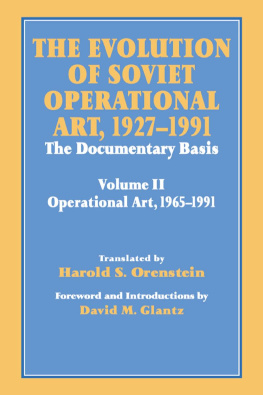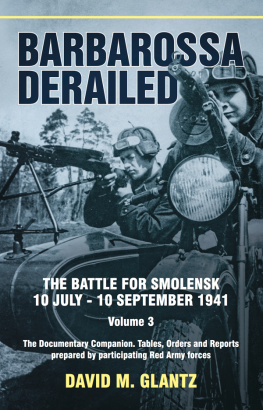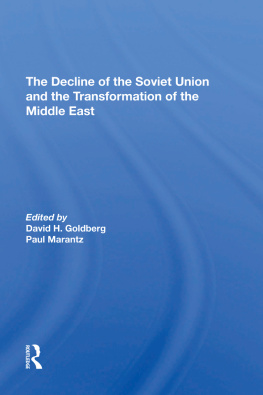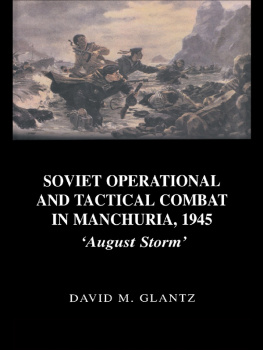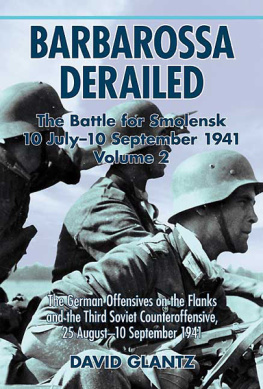David M. Glantz - The Military Strategy of the Soviet Union
Here you can read online David M. Glantz - The Military Strategy of the Soviet Union full text of the book (entire story) in english for free. Download pdf and epub, get meaning, cover and reviews about this ebook. year: 2019, publisher: Routledge, genre: Politics. Description of the work, (preface) as well as reviews are available. Best literature library LitArk.com created for fans of good reading and offers a wide selection of genres:
Romance novel
Science fiction
Adventure
Detective
Science
History
Home and family
Prose
Art
Politics
Computer
Non-fiction
Religion
Business
Children
Humor
Choose a favorite category and find really read worthwhile books. Enjoy immersion in the world of imagination, feel the emotions of the characters or learn something new for yourself, make an fascinating discovery.

- Book:The Military Strategy of the Soviet Union
- Author:
- Publisher:Routledge
- Genre:
- Year:2019
- Rating:5 / 5
- Favourites:Add to favourites
- Your mark:
- 100
- 1
- 2
- 3
- 4
- 5
The Military Strategy of the Soviet Union: summary, description and annotation
We offer to read an annotation, description, summary or preface (depends on what the author of the book "The Military Strategy of the Soviet Union" wrote himself). If you haven't found the necessary information about the book — write in the comments, we will try to find it.
The Military Strategy of the Soviet Union — read online for free the complete book (whole text) full work
Below is the text of the book, divided by pages. System saving the place of the last page read, allows you to conveniently read the book "The Military Strategy of the Soviet Union" online for free, without having to search again every time where you left off. Put a bookmark, and you can go to the page where you finished reading at any time.
Font size:
Interval:
Bookmark:

Ft. Leavenworth, Kansas

FRANK CASS & CO. LTD.
by Frank Cass
2 Park Square Milton Park Abingdon Oxon OX14 4RN
Military Strategy of the Soviet Union: History. - (Cass Series on Soviet Military Theory & Practice; Vol.5)
I. Title II. Series
355.033547
ISBN 0 7146 8200 4 (PB)
Glantz, David M.
The military strategy of the Soviet Union : a history / David M. Glantz.
p. cm. (Cass series on Soviet military theory and practice; 5)
Includes bibliographical references and index.
ISBN 0-7146-3435-2
1. Soviet UnionMilitary policy. 2. Soviet UnionHistory, Military1917- I. Title. II. Series: Glantz, David M. Cass series on Soviet military theory and practice; 5.
UA770.G55 1992
355'.0335'47dc20
CIP
Introduction
- - determines the strategic missions of the armed forces and the manpower and resources necessary to accomplish these missions;
- - formulates and implements measures to prepare the armed forces, theaters of military operations, national economy, and civilian population for war;
- - plans war and strategic operations;
- - organizes the deployment of the armed forces and their guidance during the conduct of strategic-scale operations; and
- - studies the capabilities of probable enemies to wage war and conduct strategic operations.
- - transition of the armed forces from a peacetime to a wartime footing;
- - concentration of forces on selective strategic axes (directions - napravlenie );
- - operational deployment of forces to required wartime locations;
- - deployment of "the rear" (rear services).
Font size:
Interval:
Bookmark:
Similar books «The Military Strategy of the Soviet Union»
Look at similar books to The Military Strategy of the Soviet Union. We have selected literature similar in name and meaning in the hope of providing readers with more options to find new, interesting, not yet read works.
Discussion, reviews of the book The Military Strategy of the Soviet Union and just readers' own opinions. Leave your comments, write what you think about the work, its meaning or the main characters. Specify what exactly you liked and what you didn't like, and why you think so.


